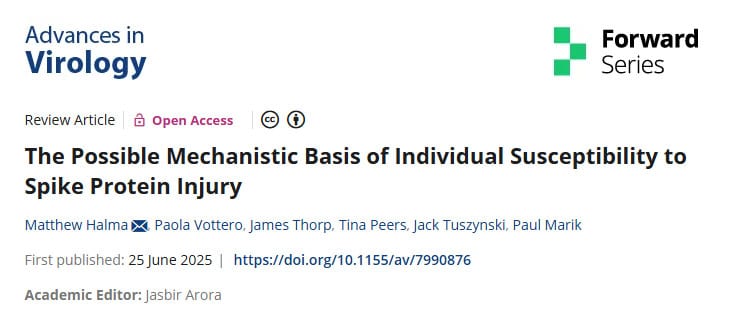Host: Dr. Paul Marik Guests: Dr. James Thorp, Dr. Jack Tuszynski, and Matt Halma
Is everyone equally at risk from COVID-19 vaccines? New IMA-backed research says no. This week, IMA Chief Scientific Officer Dr. Paul Marik is joined by Dr. James Thorp, Dr. Jack Tuszynski, and Matt Halma—three of the lead authors behind a groundbreaking study on spike protein injury.
Together, they’ll explore how the unique structure of the spike protein may affect certain tissues, how genetic and cellular factors influence susceptibility, and what this could mean for patients experiencing long-term symptoms. This conversation offers vital insights into the growing understanding of vaccine injury risk and builds on IMA’s commitment to research-driven healthcare reform.
When discussing COVID vaccines and spike protein, one critical question keeps coming up: Why do some people experience severe reactions while others seem unaffected? The answer, it turns out, involves a wide range of factors influencing an individual’s susceptibility to adverse reactions.
Some of these factors, such as batch quality, will be familiar to our longtime followers. Batch quality is relatively straightforward—the poorer the quality of the injected substance, the higher the risk of adverse reactions. But batch quality represents only the tip of the iceberg.
A recent peer-reviewed study, published in Advances in Virology, explores these deeper complexities. Titled “The Possible Mechanistic Basis of Individual Susceptibility to Spike Protein Injury,” the paper offers important insights into what makes people vulnerable to spike-related injury.
In today’s webinar, a panel of experts, including study authors Dr. Paul Marik, Dr. Jack Tuszynski, Dr. James Thorpe, and Matt Halma, discussed their research and took a deep dive into the science behind vaccine susceptibility.
If you’re looking for the highlights, here are the key topics covered:
- Why do some people react to spike protein and others don’t?
- Vaccine-specific factors: purity, dosing, and injection technique
- Natural vs. vaccine-induced spike protein: What’s the Difference?
- Therapeutics vs. vaccines: a safer approach?
- Making the Case for Better Spike Protein Testing
1. Why Do Some People React to Spike Protein and Others Don’t?
Perhaps the most significant revelation from this new research is that everybody reacts to spike protein differently.
Whether the spike protein originates from a COVID vaccine or an infection, individual reactions vary greatly due to numerous factors. Dr. Jack Tuszynski explained that these responses depend significantly on genetic differences, immune function, receptor variations, and even subtle differences in protein structure.
Understanding these variables can help us better identify who may be at greater risk from COVID vaccines or from chronic long COVID. Of course, the panelists reiterated that the best approach is to avoid the COVID vaccines altogether.
Still, it’s important to recognize that many individuals who received the vaccine experienced no negative effects at all. Conversely, others who declined vaccination but contracted COVID now face persistent health issues caused by lingering spike protein.
Dr. James Thorpe simplified this complex picture by describing two broad groups—responders and non-responders. Responders are individuals who react strongly to various medications, treatments, or substances, while non-responders typically tolerate medications and vaccines without issue.
“[I break people into] responders and non-responders… some people respond dramatically and some barely at all.” (06:35 – Dr. James Thorpe)
Interestingly, roughly 30% of COVID vaccine recipients showed no reaction whatsoever. The panel speculated these individuals might have received placebo doses or lower-potency batches, inadvertently creating an informal placebo group during vaccine rollouts.
2. Vaccine-Specific Factors: Purity, Dosing, and Injection Technique
As we’ve learned, not all COVID vaccine doses are created equal. Factors such as batch quality, purity, and even the injection technique itself can greatly influence individual reactions.
Consider, for example, the large-scale drive-through vaccination events staffed by volunteers: did everyone receive the most precise injection possible? Likely not. And the data confirm that these seemingly small variations can dramatically impact outcomes.
Matt Halma highlighted the critical issue of injection technique, citing Norway’s approach to aspiration, the process of checking for blood before injecting the vaccine, as especially effective in reducing serious reactions like myocarditis.
“In Norway, there was a lower rate of vaccine-related myocarditis… where they practiced aspiration, as opposed to other Nordic countries which didn’t.” (11:11 – Matt Halma)
The experts also discussed how the Moderna vaccine, containing double the mRNA dose of Pfizer’s vaccine, was associated with higher rates of myocarditis, illustrating the importance of dosage accuracy and consistency in vaccine safety.
3. Natural vs. Vaccine-Induced Spike Protein: What’s the Difference?
Another key revelation from the discussion was the stark difference between the spike protein produced by natural COVID infection versus the one induced by mRNA vaccines.
Dr. Marik explained:
“The amino acid structure of natural spike and vaccine spike is completely different… this has implications that we’re only beginning to understand.” (47:11 – Dr. Paul Marik)
The panelists discussed the fact that the vaccine-derived spike includes synthetic modifications (pseudo-uridine), causing it to persist much longer in the body compared to natural viral spike protein. It appears the vaccine manufacturers wanted to create RNA that was metabolized slower by the body. That may have been a great idea, if only the vaccine contents weren’t as harmful.
The presence of additional sequences, including HIV and amyloid sequences, further distinguishes the vaccine-induced spike, prompting concerns about its long-term safety and efficacy.
4. Therapeutics vs. Vaccines: A Safer Approach?
Given the unpredictable reactions associated with vaccines, the experts weighed therapeutic treatments as potentially safer and more effective options. Dr. Jack Tuszynski particularly emphasized ivermectin’s promising potential due to its short-term use, dose flexibility, and minimal side effects compared to the vaccine:
“Ivermectin actually inhibits interaction of spike with all these major proteins we discussed… a much more informed response would be to try ivermectin rather than expose ourselves to long-term effects from vaccines.” (32:22 – Dr. Jack Tuszynski)
Unlike vaccines—which offer one-size-fits-all dosages—therapeutics can be carefully tailored to individual patient responses, greatly reducing risks.
⚠️ Caution for Women of Reproductive Age:
When the topic of spike protein detox came up, Dr. James Thorpe highlighted an important caution, specifically for pregnant women. While protocols aimed at detoxifying spike protein show promise, he recommended pregnant women avoid substances like nattokinase and bromelain due to potential risks to fetal development and birth complications:
“If you know that you’re pregnant, I’m not comfortable with you using…the bromelain and nattokinase. Just because it’s natural doesn’t mean it’s safe.” (44:27 – Dr. James Thorpe)
Dr. Thorpe emphasized the need for further research into the use of ivermectin during pregnancy. However, he noted that he has safely prescribed hydroxychloroquine to immunocompromised pregnant patients for over 40 years, and his clinical observations align with existing safety data.
5. Making the Case for Better Spike Protein Testing
An urgent priority identified by the panel was the development of accurate and widely accessible tests for spike protein. Currently, individuals have limited options for reliably detecting circulating spike protein in their bodies.
If we could accurately measure the presence of spike protein, we might then be able to reverse-engineer its origin. As highlighted by Matt Halma, advanced mass spectrometry techniques could potentially differentiate between viral spike protein and vaccine-induced spike protein. The more we understand about spike protein—its source, its behavior, and its effects—the better equipped we will be to develop targeted treatments and preventive strategies for patients.
Since testing for spike protein has been a challenge to develop, Matt Halma proposed an innovative approach. He suggested a test could identify vulnerability by detecting naturally occurring compounds in the body that degrade spike protein. A deficiency in these compounds could highlight increased susceptibility and guide treatment strategies, marking a significant advancement in personalizing medicine for COVID vaccine recipients and individuals with long-term COVID complications.
The Journey Continues
This new research marks an important milestone in our mission to support those living with Post-Acute COVID-19 Vaccination Syndrome (PACVS). For years, medical science has marginalized and overlooked these individuals, lumping their symptoms under the broad umbrella of “long COVID.”
While it is true that some patients genuinely experience chronic illness from COVID infection itself, many others are clearly suffering from vaccine-related injuries. We owe it to these individuals to accurately define their condition and develop vaccine-injury treatment guides to assist them and their healthcare providers on the path to recovery.
So, in that context, we have a clear and pressing need for better medical transparency, more personalized medicine, and improved public awareness. Understanding why vaccine reactions vary so widely, whether due to genetic factors, vaccine purity, injection techniques, or therapeutic approaches, could transform our approach to medicine on the whole.
For more on this topic, stick with IMA. We’re on a mission to takedown chronic illness, which of course includes spike-related illness.
- I-Recover for post-vaccine treatment
- I-Recover for Long Vax treatment
- New IMA Study Defines Clinical PACVS
- New Study Proves COVID Injections Not “One Size Fits All”
- Journal of Independent Medicine
- Smart Moms Ask mRNA Resource Center
🤝 Support Our Mission to Restore Health and Truth
This research represents a significant step toward justice, transparency, and better health outcomes for millions. IMA is committed to advancing science that others shy away from—science that challenges powerful interests to defend the injured, uncover truths, and deliver genuine solutions.
We depend on your support to continue our groundbreaking research, create critical treatment guide, and advocate for those who suffer in silence. Your donation ensures that these important insights and solutions keep reaching those who need them most.
👉 Donate Now – Help Us Continue the Fight for Health and Transparency
Thank you for standing with us. Together, we’re changing medicine for good.





